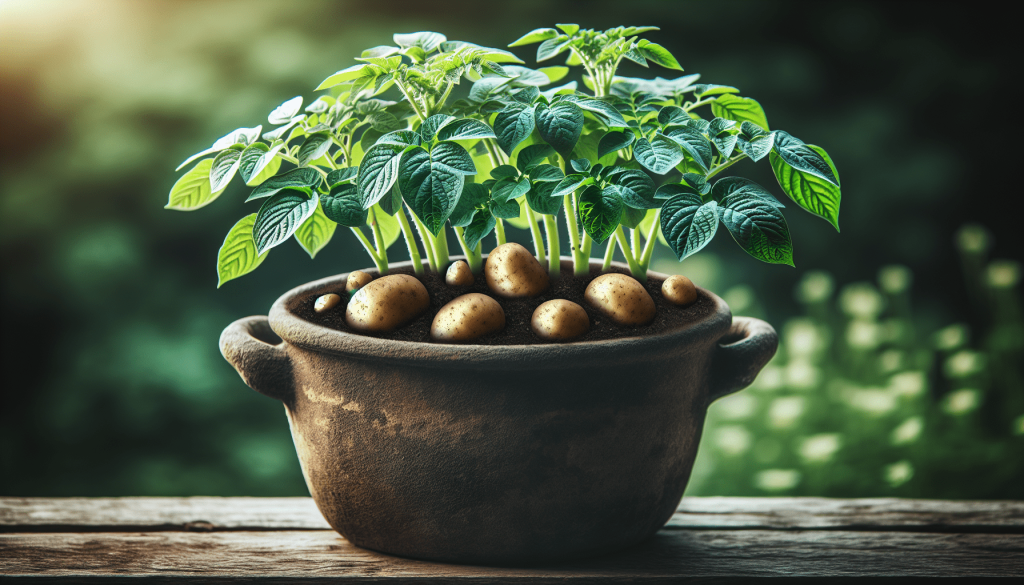This post may contain affiliate links. As an Amazon Associate, we may earn commissions from qualifying purchases.
Have you ever wondered how you might transform a small balcony, patio, or even a kitchen corner into a mini potato farm? Growing potatoes in containers could be an incredibly rewarding endeavor, allowing you to enjoy wholesome, home-grown spuds without requiring a sprawling garden. You might think it’s a complex task reserved for those with a green thumb, but rest assured, with a little care and the right techniques, anyone can harness the joy of growing their own potatoes. Let’s demystify this process and uncover some of the best methods to cultivate these versatile tubers right within the confines of your urban oasis.
Understanding Potatoes: The Basics
Before you pick up your shovel—err, container—let’s identify what makes potatoes unique and how growing them in containers can differ from traditional garden methods. Potatoes are tubers that develop underground, storing energy for the plant. Their subterranean lifestyle influences how they’re grown, particularly in pots or containers.
What Makes Potatoes Special?
Potatoes are not just the basement-dwelling cousins of the vegetable world; they offer a range of benefits, such as being a nutritional powerhouse loaded with vitamins, minerals, and fiber. Understanding their biological needs is key to a successful harvest. For instance, they thrive in cool weather around 60-70°F, which makes timing crucial for planting outdoors in most climates.
Why Choose Containers?
Using containers to grow potatoes presents several advantages: they save space, enhance drainage, and prevent pests more effectively than open soil. Additionally, containers are portable, meaning you can catch those rays of sunlight wherever they beam.
Choosing the Right Container
With potatoes, size truly does matter. Your choice of container can significantly influence the quality and quantity of your harvest. So let’s zero in on what you need in a container.
Container Size and Material
Containers come in all shapes and materials: plastic buckets, fabric pots, and even old trash cans. But when it comes to potatoes, you want something that has good depth and offers room for root growth. Go for a container that is at least 15-20 gallons in capacity, providing ample room for the tubers to swell and multiply.
Drainage Is Key
You wouldn’t want your taters swimming, would you? Proper drainage is critical. Select containers with adequate holes at the bottom to prevent waterlogging, which can lead to rot. If your chosen vessel lacks holes, drill a few yourself to ensure excess water can escape.

Selecting Your Seed Potatoes
The type of potato you plant will ultimately shape your container-growing experience. Picking the right variety and preparing them correctly is paramount for success.
Choosing the Right Variety
Not all potatoes are created equal, and some are notably better for container growth than others. It’s wise to opt for early or mid-season varieties like Yukon Gold or Red Pontiac; they mature faster and adapt well to confined spaces.
Preparing Seed Potatoes
Sprouting—or “chitting”—your potatoes before planting can give them a head start. Let them sit in a cool, light place until the shoots are around an inch long. If your potatoes are large, feel free to cut them into chunks, ensuring each piece has at least one sprout or “eye.”
Setting Up Your Growing Mix
Potatoes have a reputation for being heavy feeders, demanding a bit more than just soil to keep them happy. The right growing medium is crucial for robust plants and a bountiful harvest.
Crafting the Perfect Soil Mix
An ideal potato-growing medium should be rich in organic matter, well-draining, yet able to retain sufficient moisture. Blend equal parts peat moss (or coconut coir), compost, and perlite or sand to create a superior environment for growth.
Fertilizers and Nutrients
While potatoes are fairly self-sufficient, they benefit greatly from nutrient boosts. Incorporate a slow-release, balanced fertilizer into your soil mix, with an NPK ratio of 5-10-10, to support their nutrition needs throughout the growing season.

Planting Your Potatoes
Now comes the fun part: bringing earth, seed, and container into harmony. Discover how to set the stage for your potatoes to flourish.
Planting Depth and Spacing
Begin by filling your container with 4-6 inches of prepared soil mix. Place your seed potato pieces, sprout-side up, about 6 inches apart. Cover them with an additional 3-4 inches of soil, leaving room to add more as the plants grow.
The Art of Hilling
As your potato plants grow, continue adding layers of soil mix—commonly referred to as “hilling”—to cover the stems. This encourages more tubers to form along the buried portions of the plant. Aim to keep a few inches of the leafy tops exposed as you add soil.
Optimal Growing Conditions
You have your container, soil, and sprouting potatoes all set up. But what about their preferred living conditions? Let’s nurture your spuds like a pro.
Achieving the Right Light
Potatoes require a good 6-8 hours of sunlight daily. If your outdoor space is limited in sunlight, consider using grow lights indoors to mimic the sun’s rays.
Watering Wisdom
Since potatoes prefer consistent moisture, the key is to water frequently and evenly. Containers dry out more quickly than ground soil, so check regularly and water enough to keep the soil consistently moist but never soggy.
Managing Pests and Diseases
Your greens might grow well, but alas, intruders may come calling. Fear not—managing pests and diseases can be straightforward with the right approach.
Common Pests
Colorado potato beetles and aphids sometimes find their way to container-grown potatoes. Manual removal with a handheld vacuum or persistent blasts from a garden hose can help deter these critters without resorting to chemicals.
Disease Prevention
To ward off blight and other diseases, avoid overhead watering and ensure good air circulation around your plants. Rotate your crops each season and discard any infected plant materials.
Harvesting Your Potatoes
The moment of truth arrives: gathering your home-grown bounty. Harvesting might be the most thrilling part of the potato-growing process.
When to Harvest
Potatoes are generally ready to harvest when the foliage begins to yellow and die back. If you wish to check their progress, gently reach into the soil and feel for tubers. Leave them alone if you’re seeking larger potatoes.
Harvesting Technique
When it’s time to harvest, gently upend the container and sift through the soil to gather your potatoes. Be cautious to avoid damaging the skins as they come to light.
Enjoying Your Home-grown Potatoes
After all that nurturing and care, savoring the fruits—or in this case, tubers—of your labor is your well-deserved reward.
Storing Your Potatoes
Store your freshly-dug potatoes in a cool, dark, and ventilated space. Before storage, let them cure for a week to enhance their shelf life.
Culinary Inspirations
From buttery mashed potatoes to homemade fries, potatoes are immensely versatile in the kitchen. Experiment with different recipes to celebrate your successful harvest. Baked, boiled, or fried—potato dishes are as comforting as they are delicious.
Troubleshooting Common Issues
Sometimes, things don’t go as planned, and that’s okay. Here’s how you can troubleshoot and resolve common problems you might encounter.
Yellow Leaves
If your plants exhibit yellowing leaves before maturity, it could be a sign of nutrient deficiency, overwatering, or disease. Amend the soil with nutrients, adjust your watering routine, or assess for particular disease symptoms.
Low Yield
A disappointing harvest can stem from insufficient sunlight, overcrowding, or improper soil conditions. Address these factors in your next planting to enhance your yield.
Final Thoughts
Embracing the adventure of growing potatoes in containers offers a gratifying experience, linking you directly to your food source. Your newfound expertise will surely yield a bounty of delicious potatoes, all from the corner of your home. So grab that container and start nurturing those future fries, one layer at a time. Your potato journey begins now!








